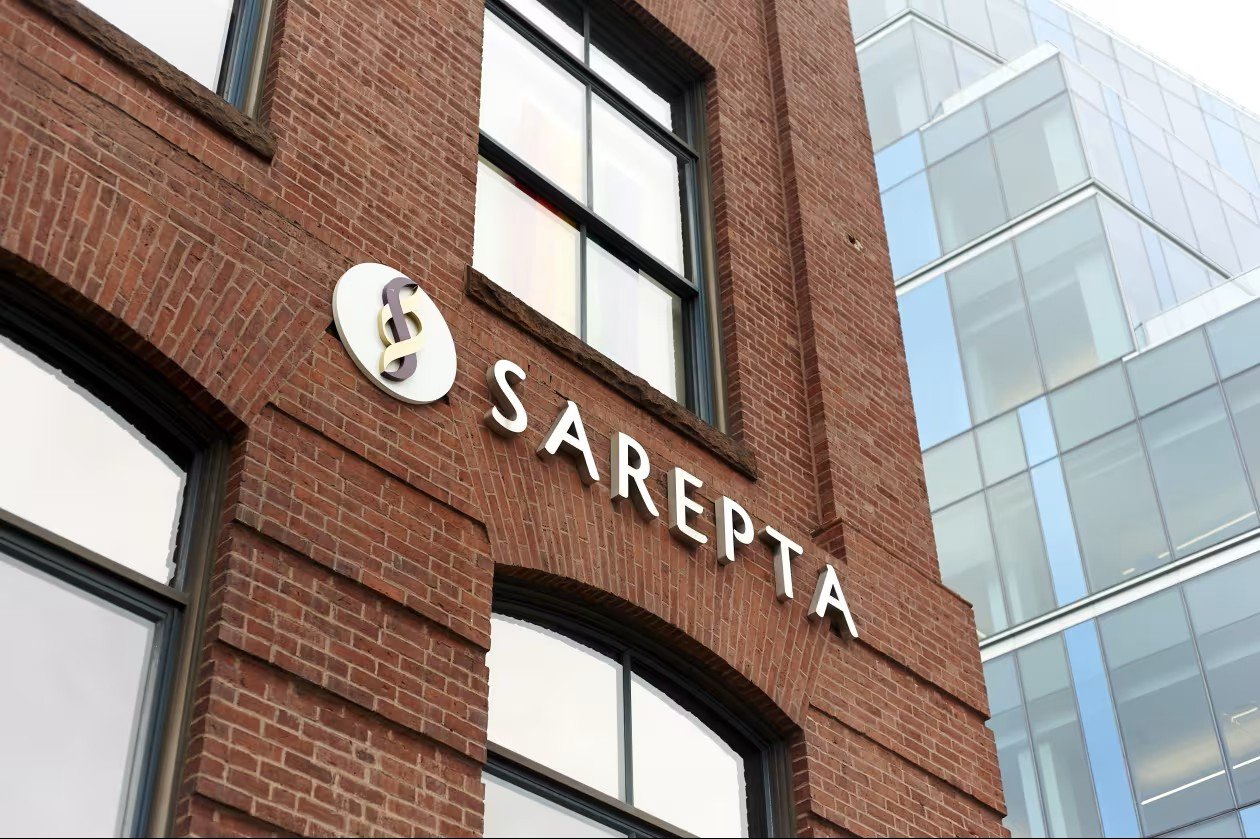The death of a third patient tied to a Sarepta Therapeutics (NASDAQ: SRPT) gene therapy this year sent the company’s shares nosediving 36% Friday, halting the momentum the stock generated just a day earlier after announcing a restructuring that entailed cutting about 500 jobs, and a pipeline pivot toward silent RNA (siRNA) treatments.
The patient—a 51-year-old man with non-ambulant limb girdle muscular dystrophy (LGMD)—died last month after being dosed in the Phase I DISCOVERY trial (Study SRP-9004-102; NCT01976091) assessing SRP-9004 (patidistrogene bexoparvovec), a gene therapy developed to treat LGMD Type 2D/R3, also called alpha-sarcoglycanopathy. DISCOVERY is a proof-of-concept study designed to assess the safety and expression of the alpha-sarcoglycan protein after treatment with SRP-9004.
The death comes four months after Sarepta acknowledged the death of a 16-year-old young man with Duchenne muscular dystrophy following treatment with its marketed gene therapy Elevidys® (delandistrogene moxeparvovec-rokl), and just over a month after the company disclosed the death of a second Elevidys patient, whose age has not been disclosed.
Late on Friday, Sarepta refused an FDA request to voluntarily halt shipments of Elevidys—a request made after it first surfaced in news reports, the company said in a statement.
“Based on our comprehensive scientific interpretation of the data, which shows no new or changed safety signals in the ambulant patient population, we will continue to ship Elevidys to the ambulant population,” Sarepta stated. “We look forward to continued discussions and sharing of information with the FDA in order to advance our shared purpose of protecting patient safety and informed access to care.”
As with the two Elevidys patients, the LGMD patient who died succumbed to acute liver failure (ALF) after treatment with SRP-9004, a recombinant, adeno–associated viral vector (AAV) gene therapy. SRP-9004 is designed to deliver a full-length alpha-sarcoglycan transgene SGCA using the AAVrh74 vector, which, according to Sarepta, is designed to be systemically and robustly delivered to skeletal, diaphragm, and cardiac muscle.
Sarepta did not disclose the LGMD patient death on Wednesday when it announced it would “pause” development of SRP-9004 among most of the LGMD therapy candidates in its pipeline. The company still plans to submit a Biologics License Application in the second half of this year for its furthest-along LGMD candidate SRP-9003, a gene therapy designed to treat LGMD type 2E/R4.
“We did not discuss the matter on our call on Wednesday because it was neither material nor central to the topics at hand on Wednesday,” Sarepta CEO Douglas S. Ingram told analysts Friday on a conference call to discuss the LGMD death, adding: “This wasn’t salient to our discussions.”
Analyst challenges CEO
Yes, it was, countered Brian P. Skorney, a senior research analyst covering biotechnology for Baird, challenging Ingram: “It seems very clearly that this was a material event.”
Skorney downgraded Sarepta shares from “Outperform” to “Neutral,” citing what he called uncertainties about the company’s transparency and the future of Elevidys.
Skorney was not alone in sharing transparency concerns.
“Sarepta’s board should fire Doug Ingram tonight and then all resign themselves. The company needs a reset over the weekend for the sake of patients, and to preserve public trust in the biotech industry,” fumed Brad Loncar, a longtime biotech investor and founder of BiotechTV, in a Friday post on X.
Sami Corwin, PhD, a biotechnology-focused healthcare analyst with William Blair, wrote that while development of SRP-9004 has been discontinued, “we believe the death could lead to greater scrutiny of SRP-9003’s safety profile ahead of its BLA submission and could affect commercial interest, if approved.”
“In addition, we think the LGMD patient death could amplify patient hesitancy to use commercial Elevidys and increase investor distrust since the company did not disclose the event on its call on June 16,” Corwin added.
Investors clearly agreed with Corwin, Skorney, and other skeptical analysts. Shares of Sarepta had been declining 13–14% at the start of trading Friday until the conference call. After that call, shares plummeted further, falling 42% to a 52-week low of $12.83 before finishing the day with a 36% decline at $14.07, thanks to investors who snapped up the lower-price shares in hopes of a quick profit, what Wall Street calls “buying the dip.”
The stock plunge contrasted with the 19.5% surge Sarepta shares enjoyed just a day earlier on Thursday, from $18.38 to $21.97, after the company said Wednesday after market close that it will eliminate 36% of its workforce—approximately 500 jobs—and pivot much of its research and development toward therapies for five rare genetic diseases that were developed through its silent RNA (siRNA) platform, and away from gene therapies such as Elevidys.
One key reason behind Thursday’s surge: Sarepta revealed that the FDA had requested that Elevidys’ label include a black box warning for ALF and acute liver injury, a request supported by Sarepta. Investors were relieved that the agency did not withdraw the drug from the market.
The future of Elevidys should be of no small concern to Sarepta. Elevidys accounted for 55% or $282 million of Sarepta’s total net product revenue of $513 million during the second quarter, on top of 61% or $375 million of the company’s $611.5 million in Q1 net product revenue. The remaining net product revenue in both quarters was generated by Sarepta’s three RNA-based phosphorodiamidate morpholino oligomer (PMO) treatments, which, like Elevidys, are also indicated for DMD.
“Seeing a third SRPT-related death occur within a span of four months will raise questions about SRPT’s gene therapy platform. Serious downside risks (i.e., deaths) have been challenging to handicap, which could cause near-term stock exhaustion,” cautioned Andrew Tsai, equity analyst with Jefferies, in a Friday research note.
“Naturally” arising questions
Tsai wrote that two questions “naturally” arise from the LGMD death:
- How will Vinayak (Vinay) Kashyap Prasad, MD, director of the Center for Biologics Evaluation and Research (CBER), view Sarepta’s gene therapy programs now, since all are based on AAVrh74?
- Could ambulant DMD patients, their families, and their physicians rethink treatment with Elevidys as it and SRP-9004 share the same AAVrh74 vector?
“One could point to an emerging theme whereby the deaths are occurring in older patients who generally take much higher doses of drug, which could be causing fatal ALF,” Tsai observed. “However, investors will unlikely entertain the notion that the prevention of deaths is fully manageable at this juncture, especially with three deaths occurring within a span of four months [and in multiple programs].”
Tsai also noted that SRP-9003 received the FDA’s Platform Technology Designation last month, a move he said signaled the FDA’s endorsement of Sarepta’s broad AAVrh74 platform.
Tsai also lowered Sarepta’s 12-month price target from $54 to $45. Analysts at several other investment firms lowered their 12-month price targets on Sarepta stock as well, including:
- BMO Capital (Kostas Biliouris)—Down 29%, from $70 to $50.
- BofA Securities (Tazeen Ahmad)—Down 29%, from $28 to $20.
- Oppenheimer (Andreas Argyrides)—Down 9%, from $45 to $41.
- RBC Capital (Brian Abrahams)—Down 8%, from $25 to $23.
When Sarepta disclosed the death of the LGMD patient Thursday, it did so through a statement emailed to news outlets rather than via press release or regulatory filing, as occurred with the two Elevidys patients.
“Our deepest condolences go to the family and all those involved in his care,” Sarepta stated. “Advancing the science of genetic medicine is incredibly challenging, especially in ultra-rare diseases like the limb-girdle subtypes. While we do everything possible to ensure patient safety, there is inherent risk in clinical trials, and we are grateful to the courageous patients and families who participate.”
SRP-9004 was originally developed by Myonexus Therapeutics as MYO-102, until Myonexus entered into a collaboration with Sarepta in 2018 to develop that gene therapy and four others designed to treat LGMD. All five applied the same gene therapy platform that was licensed from Nationwide Children’s Hospital, with the aim of systemically and robustly delivering treatment to cardiac and skeletal muscle, including the diaphragm, without promiscuously crossing the blood-brain barrier.
In 2019, Sarepta exercised a purchase option and acquired Myonexus for $165 million, in a deal intended to broaden the buyer’s pipeline.
“Our confidence in these programs has come from the fact that our micro-dystrophin gene therapy and the Myonexus programs have much in common, including inventors from Nationwide Children’s Hospital, a shared vector in AAVrh74 and, to date, similar preclinical safety data,” Ingram stated at the time. “We are excited to acquire Myonexus, which will allow us to move rapidly to find solutions for LGMD patients and continue to build out and validate our gene therapy engine.”
Pharmas, funds stable despite tariff talk

When President Donald Trump first spoke about imposing tariffs on drugs imported into the United States earlier this year, it sank the stocks of biopharmas, from drug developers to tools/tech companies. But this past week, after Trump publicly discussed levying biopharma tariffs as soon as August 1, biopharma stocks serving the industry hardly flinched.
Speaking to reporters on July 15, Trump restated his earlier-announced plans to levy biopharma tariffs starting at a rate low enough to encourage the shifting of manufacturing to the United States, then ratcheting them up well into triple digits.
“Pharmaceuticals will be tariffed, probably at the end of the month,” Trump said. “You make money, and/or you have them move here so they don’t have to pay the tariffs.”
He added: “We’re going to start with a low tariff and give the pharmaceutical companies a year or so to build, and then we’re going to make it a very high tariff.”
As high as 200%, Trump told his Cabinet a week earlier: “They [biopharmas] went to other places because people that sat in this room allowed it to happen, and I don’t allow it to happen.”
Among the top three legacy pharmas based on market capitalization (share price times number of outstanding shares), Eli Lilly (NYSE: LLY) barely blipped up 0.02% from $771.75 to $771.91 after initially climbing 2% to $789.80 on Wednesday. Johnson & Johnson (NYSE: JNJ) jumped 5.5% from $155.17 to $163.67, buoyed by a 6% jump Wednesday (to $164.78) after the company raised its earnings per share (EPS) and sales guidance to investors following positive Q2 results. AbbVie (NYSE: ABBV) increased 1.5% from $186.39 to $189.26.
The top biotech by market cap, Novo Nordisk (Nasdaq Copenhagen: NOVO.B), fell 4% from DKK 433.10 ($67.45) to DKK 414.60 ($64.57). Of the two largest U.S. biotechs, Amgen (NASDAQ: AMGN) inched up 0.8% from $292.51 to $294.76, while Thermo Fisher Scientific (NYSE: TMO) dipped 0.8% from $417.99 to $414.83.
Rising more uniformly were the top three exchange-traded funds (ETFs) focused on pharma and/or biotech stocks. The largest, iShares Biotechnology ETF (NASDAQ: IBB), increased 0.5% from $129.05 to $129.73, while the second-largest biotech ETF, SPDR S&P Biotech ETF (NYSE Arca: XBI), barely rose 0.3% from $85.91 to $86.20, and the third-largest fund, ARK Genomic Revolution ETF (NASDAQ: ARKG), climbed 2% from $24.33 to $24.91.
“Net-net, it seems like tariffs have gone from being a major overhang for HC [high-capitalization companies, namely biopharma giants] to something that could be more manageable,” Jefferies analyst Akash Tewari wrote in a research note whose headline scoffed at the fear with which market watchers (including him) initially viewed the planned duties on imported drugs: “Tariffs schmariffs—Why the Trump pharma announcement is noise.”
Tewari offered three reasons why biopharmas have now come to view tariffs as a manageable challenge:
- Inventory and capacity: Several biopharma giants told Jefferies they were stockpiling inventory ahead of tariffs taking effect, and that they had the ability to ramp up manufacturing capacity in the United States.
- Grace period: Trump’s 12- to 18-month grace period could extend into a two- to three-year period since it takes at least that long to bring manufacturing facilities online. Stockpiled drugs “could cover demand through 2H28/1H29,” Tewari said, as small molecules and injectables have a reported storage life of 18 to 24 months.
- EPS impact: Tewari foresees a “modest single digit %” EPS impact for Merck & Co. (NYSE: MRK) in 2027–28—between 1–2% and 5–9% depending on how much in drugs it stockpiles, and how quickly it can step up U.S. manufacturing.
The United States last year exported $95 billion in pharmaceutical products—but imported more than double that amount, about $200 billion, according to investment research and management firm Morningstar.
Leaders and laggards
- Aptorum Group (NASDAQ: APM) shares doubled, zooming 100% from 97 cents to $1.94, on Wednesday after the oncology and infectious disease drug developer said it had entered into an all-stock merger of undisclosed value with privately held DiamiR Biosciences, a developer of blood-based tests for brain health and other diseases with a CLIA-licensed, CAP-accredited clinical lab in New Haven, CT. DiamiR will keep its name and become a wholly-owned subsidiary of Aptorum. The combined company expects to remain listed on Nasdaq. The boards of both companies have approved the merger, which is expected to close in the fourth quarter, subject to stockholder approval from both companies and other customary closing conditions.
- Prime Medicine (NASDAQ: PRME) shares climbed 22% from $3.11 to $3.80 on July 7 after JonesTrading analyst Soumit Roy labeled the prime editing therapy developer a “prime candidate” for acquisition, before adding: “It is unlikely to happen without clinical data from their Wilson Disease or AATD programs, which we estimate will be in 2027,” as reported by Seeking Alpha. Roy cited growing interest by pharma companies in gene-edited therapy developers after Eli Lilly (NYSE: LLY) agreed to acquire Verve Therapeutics (NASDAQ: VERV) for up to $1.3 billion last month. The analyst also observed that momentum for Verve stock is being driven by a large price/valuation discrepancy, insider share purchases since mid-May, and interest among short-selling investors. JonesTrading rates Prime shares as “Buy” with a 12-month price target of $5. Prime shares have since risen another 9%, to $4.13 at Friday’s close.
- Rani Therapeutics Holdings (NASDAQ: RANI) shares tumbled 39% from 70 cents to 43 cents on July 15, after the company said that entered into a securities purchase agreement with an undisclosed single institutional investor for the purchase and sale of 4.354 million shares of Rani’s Class A common stock at 40 cents a share and pre-funded warrants to purchase 3.146 million shares of Class A common stock at about 40 cents a share in a registered direct offering. The purchase price was 43% below the previous day’s close, touching investor concerns about liquidity, according to a published report. Maxim Group is acting as the sole placement agent for the offering, which was expected to close on or about Wednesday, subject to satisfaction of customary closing conditions.
The post StockWatch: Sarepta Shares Nosedive after LGMD Gene Therapy Patient Dies appeared first on GEN – Genetic Engineering and Biotechnology News.




